My grandfather grew tomatoes in the greenhouse. My father grew tomatoes in the greenhouse. So I’ve grown tomatoes in the greenhouse.
Are home-grown tomatoes off the menu if you have no greenhouse?
Here I describe my experiment with outdoor growing in the summer of 2019 and give my top variety to try.
The post contains a useful Youtube clip on how to cordon your tomatoes.
Glasshouse vs outdoor growing in the UK
If the tomato were a person – I imagine a sun-kissed Italian basking in the kitchen garden with a glass of Chainti. Sun loving and revelling in life outdoors.
But the UK climate is not Italian. We have fewer sunshine hours and lower light levels and a shorter growing season than the Med.

A nostalgic picture of my late father tending his veg in front of a greenhouse crammed with tomatoes – but could he have grown some outside?
There are therefore certain advantages to growing tomatoes under glass in the UK. Long hot summers are not guaranteed so the energy amplification of glass and the extended growing season are so useful. Greenhouse grown tomatoes are also less susceptible to blight than those grown outside.
Watering is an important consideration. On a sunny day in summer I will water my greenhouse tomatoes twice a day. Admittedly, they are container grown but regular watering is important to ensure good growth and prevent poor ripening. Outside, especially in good soil, less frequent watering will be required as the plant will lose less moisture to the atmosphere than in a hothouse.
Many people who want to grow tomatoes just don’t have a greenhouse of course. They’re an expensive investment, unsuitable for the smaller garden and impossible on a roof terrace or balcony.
The good news is that it is possible to grow good tomatoes outside in the UK. Admittedly, a grey wet summer – such as the one we had in 2012 – will reduce the productivity but you will still get a crop. A summer like the one we had in 2018 was perfect for tomatoes outdoors so long as you were on top of the watering.
You can’t control the weather but to ensure good productivity it’s worth considering a few factors to help decide where to grow them and which varieties to choose.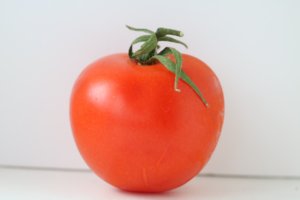
Let’s go outside – where will you grow your tomatoes?
The first thing to think about when growing tomatoes outside is how much room you have to grow tomatoes in. There is a tomato variety out there for any sized garden, be it a tumbling cherry variety for a window box or neat rows at an allotment. What space do you have and how much of it do you want to devote to tomatoes?
It’s also worth considering aspect. A sunny south facing spot against a wall or fence will be the next best thing to a greenhouse. A cold north-facing roof terrace will be a less safe bet as it will barely see the sun. Think of the sunniest spot in your garden and consider if you can squeeze a tomato plant in. If it’s a patio then you could consider a variety suitable for a pot. If it’s a shrub border – could you countenance a tomato plant nestled amongst the bushes?
When you’ve chosen your site, think also about the soil. Tomatoes are hungry feeders so a good soil, enriched with compost will get your tomatoes off to a good start.
Think also about water. Tomatoes need allot of water. Tomatoes planted in a corner of the garden distant from a tap or water butt will be less likely to be watered regularly than a pot by the back door.
Finally think about what type of tomatoes you like to eat. Do you like a big variety to slice in a cheese and tomato sandwich, or do you like little cherry varieties to pop in your mouth as you sit in the garden? Do you want a heavy cropper where lots of fruit will be ready at the same time to make a delicious soup or would you rather pick a handful a week for use in a variety of dishes?
Bush Vs Cordon varieties
When you look on the websites of seed suppliers or read the packets in a shop or garden centre you may see tomato varieties described as ‘Cordon’ or ‘Bush’ and also ‘Determinate’ or ‘Indeterminate’. They may initially confuse a new grower, but understanding what they mean will help you in choosing your varieties and in how to care for them when they are growing.
Determinate or bush tomatoes, grow in a loose or bushy shape and don’t need training, although they may need some support if they get leggy. They usually grow to a compact height – thigh or waist level at a push and they stop growing when fruit sets on the top bud. Most determinates are well suited to growing in a container on a patio. You will find the fruit on most bush varieties ripen within a couple of weeks rather than continually setting and fruiting throughout the season.
Indeterminate or cordon varieties should continually grow and produce fruit until the end of the growing season in late autumn. They can grow tall so it is common to stop their growth at a supportable height and allow 5 or 6 side trusses to develop, grow and ripen. Because they grow tall they require careful staking. Side shoots will need to be removed to train the cordon.
A word about Blight
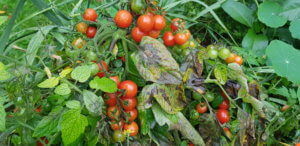
Leaves showing brown blotches of blight. If not removed the blight will spread to more leaves and stems and the plant will collapse in a mushy heap.
Generally, I find that plants grown outside are less susceptible to diseases than greenhouse ones. Getting the atmosphere in a greenhouse right in all weathers can be problematic. Once a pest or disease gets into your greenhouse it can spread easily from plant to plant.
A devastating disease called blight is, however, more likely outdoors. It thrives in damp environments so will be more prevalent in cooler wet summers. Once it takes hold it can destroy your tomato plants. The first signs of blight are dark brown patches at the edge of the leaves. The area affected expands until the leaves are killed and stems become affected too.
No foolproof treatment exists for blight but technology is helpful in the form of the Met Office’s blightwatch website which tracks its spread each year. When you know it’s coming you can minimise its impact by making sure your plants have good air circulation, trimming off excess leaves and stems to expose the fruiting trusses to good air flow. Some growers even advocate taking every leaf off a plant when blight is in the air as the fruits can ripen regardless.
Far and away the best protection against blight is to choose blight resistant varieties. Fortunately seed growers have developed more blight tolerant varieties and growers have trialled various types in the UK climate to discover outdoor winners.
Suggested varieties
I’ve researched websites, seed catalogues and asked around in the gardening community to discover the best ones to suggest to my readers. They are summarised in the table below. If you can’t read it well, click on the image and it will open larger.
Not all seeds are available from every supplier so shop around and check a few online suppliers.
I’ll be trialling 4 varieties in my own garden – outside- in 2019. I’ll be sharing further information on seed sowing, planting out, training and support throughout the season.
June 2019 Update – How are my outdoor toms faring?
All four varieties sown back in March are doing very well. I chose to grow Lizzano (Determinate/bush variety) and Fandango, Outdoor Girl and Gardener’s Delight as cordons (indeterminate). Outdoor Girl was not suggested to me by fellow gardeners but was an impulse buy based in its name.
I started them off in seed trays indoors, potting on in april and then planting out in the garden in late May. A few cold nights and threatened late frosts meant I did wait until almost June to plant them out and they were a bit pot bound and sickly, in need of root space and sustenance by the time I planted them out. They soon greened up and started growing very well.
The three cordon varieties are about 70 cm tall and trained either up canes or up string cordons on crossed hazel canes, a method I saw last year at Barnsdale Gardens. If you want to know more about training tomatoes as cordons I’ve done a You tube clip, which you can see below.
I’ve been keeping an eye on Blightwatch as after a warm and dry early summer, June turned very wet. At least one day had a high blight warning but the warmth and sun has returned and so far there are no obvious sign of blight.
Autumn 2019 update – Post season analysis
My experiment was a success and I will definitely grow tomatoes outdoors again. I am aware that in a wetter summer the results could have been very much worse but the cost was just over £10 for four seed packets and I was rewarded with huge numbers of fruits. My favourite variety was ‘Outdoor Girl’ and I will just grow this variety next year. These seeds cost around £3 a packet.
There were many days when Blightwatch alerts appeared on my mobile phone and the frequency of these increased as the season progressed.
Despite this, and despite the fact that blight did eventually affect all my tomato plants, I still got an excellent crop. By the end of the season I had more tomatoes than I knew what to do with and ended up making soups and pasta sauces to freeze.
Here’s how I found my four chosen varieties performed.
- Lizzano was a very heavy cropping cherry but succumbed quickly when blight took hold. A bush variety so it couldn’t be cordened to increase airflow. As blight took over I harvested the fruits all at once and filled the base of a large washing basket.
- Fandango was a very large, tasty and attractive variety. Good for slicing in sandwiches but not the heaviest cropper per truss. Blight took hold before all fruits ripened.
- Gardeners’ Delight – Cropped well with tasty medium sized fruit. Blight did affect it but not before most of fruits had ripened
- Outdoor Girl – My top variety – heavy crops of useful and tasty middle sized fruits. Blight took longer to take hold and most harvested before it did so.
Happy growing and do let me know if you’ve any comments on tomato growing.
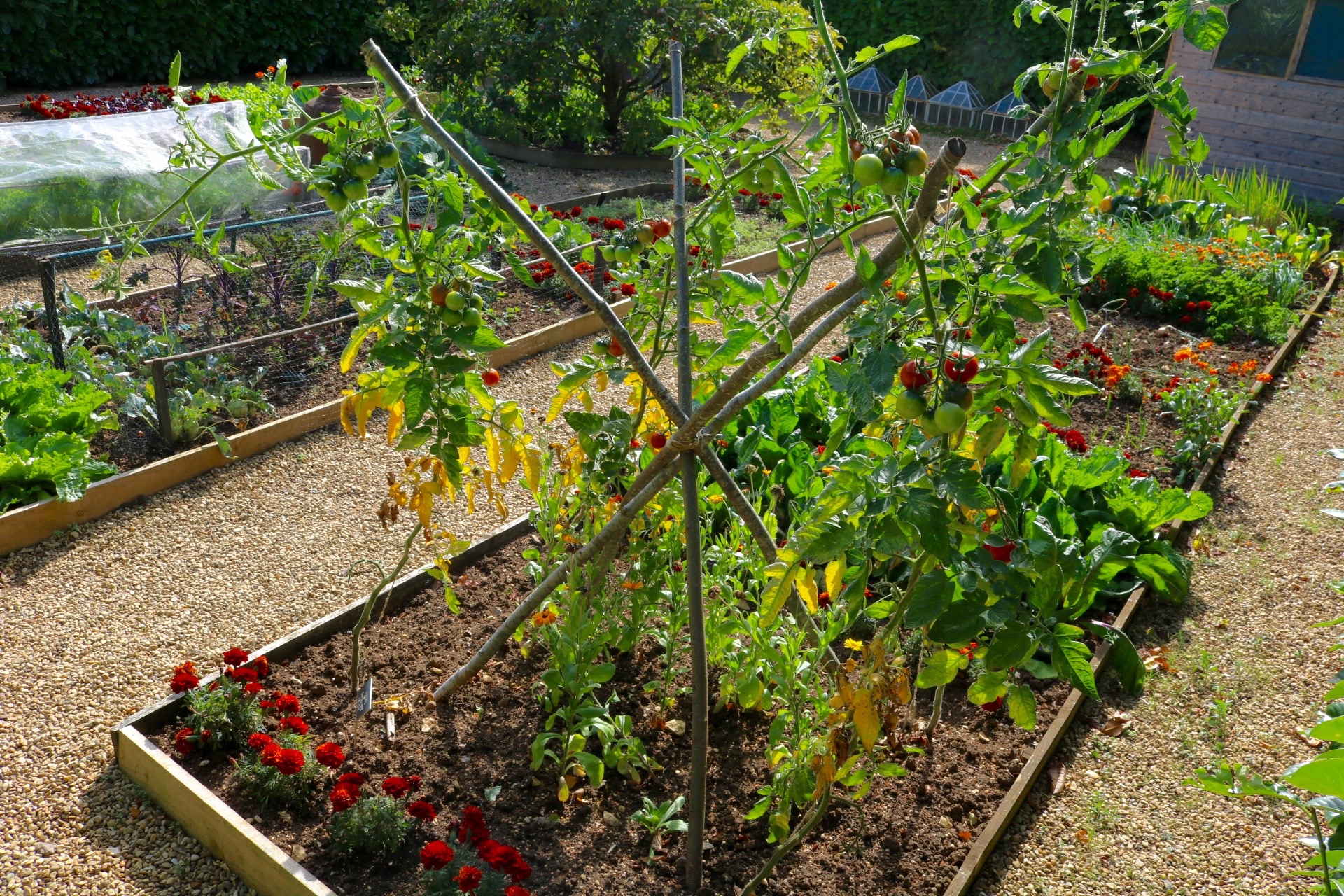
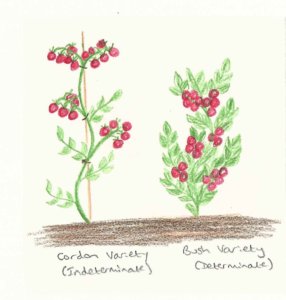
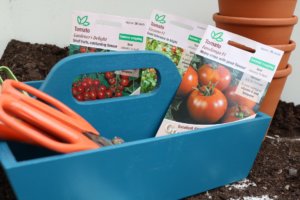
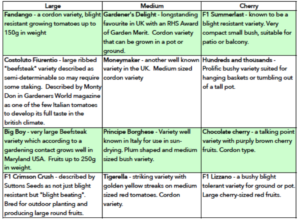
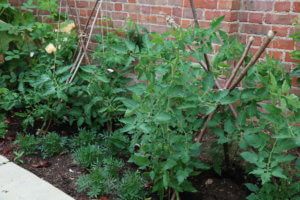
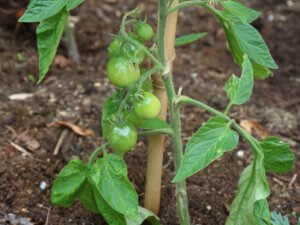
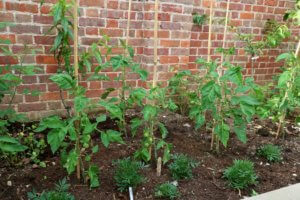
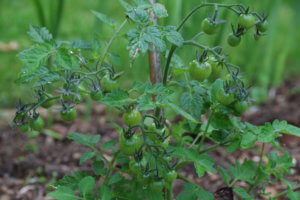
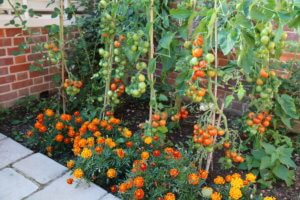

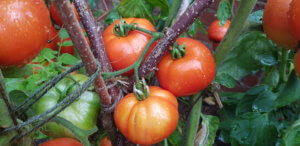
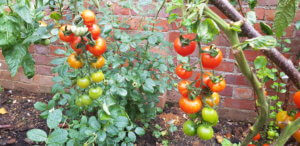
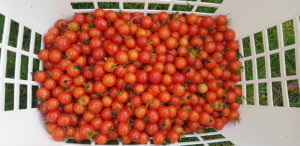
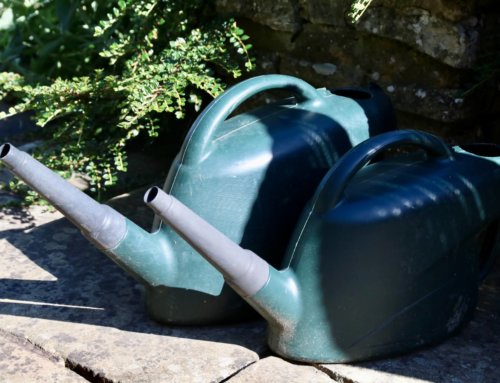
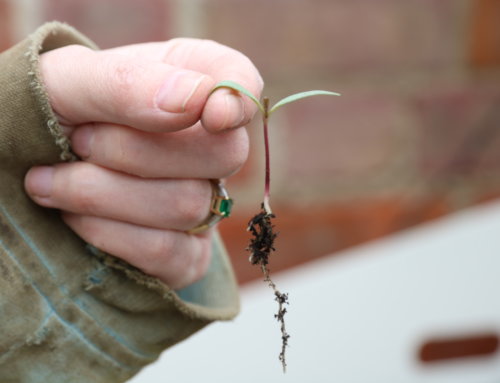
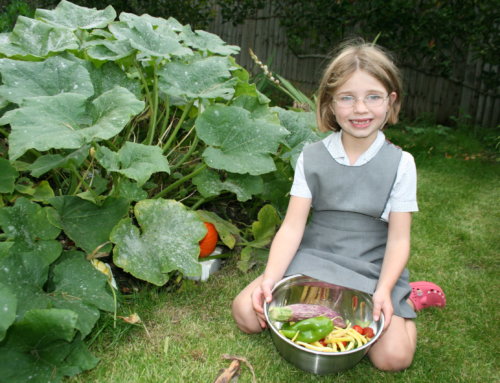
I have tomatoes in pots against a south west wall. They appear to be doing well and after reading advice I will look how many trusses are set and perhaps pinch out the top and remove some lower leaves. I planted French marigolds with them in the pots and these have been totally eaten away, should I remove them and plant replacement marigolds.
French marigolds look lovely alongside tomatoes and there is some evidence that the scent deters some pests. I’d only replace them if you can afford to and if you like the look but I’m sure the tomatoes will be fine without them. Hope they taste great!
There is a treatment to protect agiant blight used in France, Bordelaise Mixture. It is a copper sulohate powder dissolved in water 20 to 1 and sprayed over leaves before planting out and then repeated before signs of heavy rain and damp sunless days. If blight takes hold it won’t stop it but removing affected leaves immediately and removing them from the vicinity then respraying the remaining ones may help.
Fench margolds do natually attract whitefly and other pests so should be planted among the tomatoes plants. |Grwo them from seed at the same time as the Toms then plant out one to four tom plants.
Hi Chris – great tips and excellent info on that treatment. This was a bit of an experiment to see what sort of crop I could get by choosing supposedly blight resistant varieties and without going to too much fuss. Whilst blight did eventually take hold, I still got an excellent crop of several kilos off my plants. I’ve seen various amateur gardeners give up on growing tomatoes without a greenhouse but this little experiment showed it is possible to get a good crop. Of course this was a fairly dry summer which did help!
Hi Chris, this is the first time i’ve grown tomatoes. I bought beef master f1 plants and watered them for a couple of weeks or so. But wrongly planted them outside witg fertiliser and feed:-( Is there any way i can rescue them to flower so they produce fruit? Please help
Hi Sarita – just wanted to be clear what the problem is. Have your toms got blight? Or are they not flowering? Or both?
Where can you buy the outside seeds from thanks Dave from Darlington
HI Dave. Do you mean the ‘Outdoor Girl’ variety? If so this I bought mine from Mr Fotgergill’s seeds. Mail-oder is your best bet at the moment during Government Covid-19 restrictions. Shop around online and see what you can get hold of. Many seed suppliers have been inundated with orders recently for all sorts of seed but many are still taking and sending orders. Good luck. Katharine
The variety ‘Ferline’ is excellent outdoors – chunky tomatoes, great taste and very blight resistant.
Good information about tamoto
[…] tomat di kebun via http://www.teabreakgardener.co.uk […]
I always grow Outdoor Girl outside and get a good crop. This year I have tried Orange Queen and Pink Caspian alongside them and they are going great guns too well worth experimenting in my opinion as they only cost me the price of a packet of seeds !
Hi Debbie, good to have some new suggestions of toms that grow well. You’re right about giving things a try. Seeds don’t cost much but you can really strike gold.
[…] A developing truss of cordon tomatoes growing up a cane Image: The Tea Break Gardener […]
[…] A growing truss of cordon tomatoes rising up a caneImage: The Tea Break Gardener […]
I have planted some piccolo tomatoes, but no instructions on the packet. Can I grow them outdoors? Are they a tumbling tomato? Do they need training up a cane? I am an inexperienced grower so any advice would be very welcome. Thank you.
Hi Jennifer – it’s a bit unhelpful that there are no details at all but nothing ventured nothing gained! This is not a variety I’ve grown before but I think with a name like that it must be a cherry tomato and I would think you could have a go at growing them outdoors. Some cherry tomatoes are tumbling varieties, some are bush and some are cordon (which need training up a cane or support). The best thing to do will probably to try growing up a cane. If it’s a bush or tumbling variety this won’t do it any harm whereas if it’s a cordon it will definitely need some support. Don’t plant your seedlings outdoors until the weather warms up a bit. Good luck and let me know how you get on.
I live in the middle of Scaninavia at 60 degrees latitude and circa 100 meters above sea level. I usually sow tomatoes around the spring solstice and grow them up on the room windows. I plant them in an unheated greenhouse around June 10th. I use plastic buckets with a hole drilled in the bottom in the bottom. I water the plants with rainwater – it makes difference compared to tap water (no salt accumulation in the buckets after the season).. The years are different, sometimes the disease comes to the greenhouse in mid-August. This year is mid-September with no symptoms. My favorite variety is “Krainij Sever” (“Ultimate North” in Russian). I gave some plants to my neighbours and they growed them successfully outside besides the southern brick wall. For the last two years, in the beginning of September, I have brought some plants into the room and placed them under a large plant lamp. The harvest continued until November, the plants survived the winter in the room and began to bloom again in March. I took one of them back to the greenhouse in mid-June. It still grows there, but this year yielded less and the tomatoes were “woody”..
I am really sorry for the spelling mistakes. The text is not clearly visible to my old eyes on this website as I write it. I wanted to add that the buckets are the ones used for concrete work and I bought from a construction store (special black plastic). An ordinary plastic bucket decomposes in the sun in a few months. Of course, nothing is known about the release of chemical substances to the soil under the time of growing.
Don’t worry at all about the spelling mistakes. It sounds like you have some good plastic tubs there which will last for many a season.
Hi Rainer – I’ve really enjoyed reading about how you grow your tomatoes there in Scandinavia and it sounds like you have varieties available to you which grow well in your climate. Bringing the plants indoors to prolong the growing season obviously works well, although I think my family may object!
I have loads of tomatoe plant s growing in my greenhouse ,just wondering if I could put some outside as I think there’s too many in there . I live in South Wales with a South facing garden .
Hi Kerry, sorry for the very long delay in responding. As I mention in the article, outdoor plants will usually succumb to blight, although this is very weather dependent. If you have lots of plants there is is no harm in trying some inside the greenhouse and others outside. What have you got to lose?